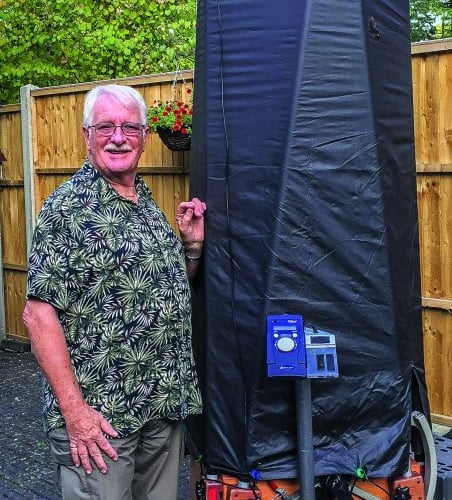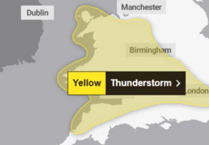VIEWS of the night sky are the clearest in decades – due to the unprecedented reduction in pollution and clouds formed by airliner vapour trails during the COVID-19 pandemic.
Amateur astronomer John Axtell, who is locked down at his home in Pyrford, says this means that now is the time to look up at the planets and stars.
John, a Fellow of the Royal Astronomical Society, has been hooked on studying celestial objects and phenomena since childhood.
“It was the adventures of Dan Dare that inspired me,” said John, who was an avid fan of the Eagle comic’s stories about the Pilot of the Future in his boyhood.
“Exploring the ever-changing sky is a fantastic hobby and binoculars are a great way to see the sky at night. They gather more light than the naked eye and magnify objects so that you’ll see the craters on the moon in more detail.”

John has a 9ft high telescope in his garden and stands on a ladder to look through the eyepiece. The instrument, made in the USA, uses curved mirrors to magnify and reflect light to form an image.
He has taken photographs of celestial objects, including the moon, using an iPhone attached to the telescope eyepiece.
John talks about all things astronomical, and what the stars and planets have got in store for us, in a Brooklands Radio programme. The show, Stars Over Surrey, is broadcast on the last Friday of the month at 7.20pm.
The station can be listened to online at www.brooklandsradio.co.uk and on DAB radios in the Woking area. John’s programme is also available as a podcast through the website.
Media publicity about the “super moons” seen in March and April have added to the popularity of star gazing, and the moon can will appear extra-large again on Thursday 7 May. For other things to look at, there are many apps that will identify objects in the night sky.
John says this spring is a good time for planet-watching, as the bright planet Venus is unmissable to the west all evening and Mars, Jupiter and Saturn can be seen in the pre-dawn sky. Jupiter’s moons are even visible through a good pair of binoculars.
The International Space Station can regularly be seen over Surrey as it orbits the Earth, and is easily spotted by the naked eye assunlight reflects off its solar panels. The Nasa website – www.nasa.gov – will tell you when it is next passing over
And keep your eyes peeled for the peak of the annual Eta Aquarids meteor shower, due to will occur on Tuesday and Wednesday, 5 and 6 May. You could see up to 35 shooting stars an hour if the skies are clear.
The recently discovered Comet Swan might also be visible to the naked eye during the second half of May.



-Imam-Adeel-Shah-Mr-Razwan-Baig-Nicky-Banger-and-Mr-Amer-Safer.jpeg?width=209&height=140&crop=209:145,smart&quality=75)
